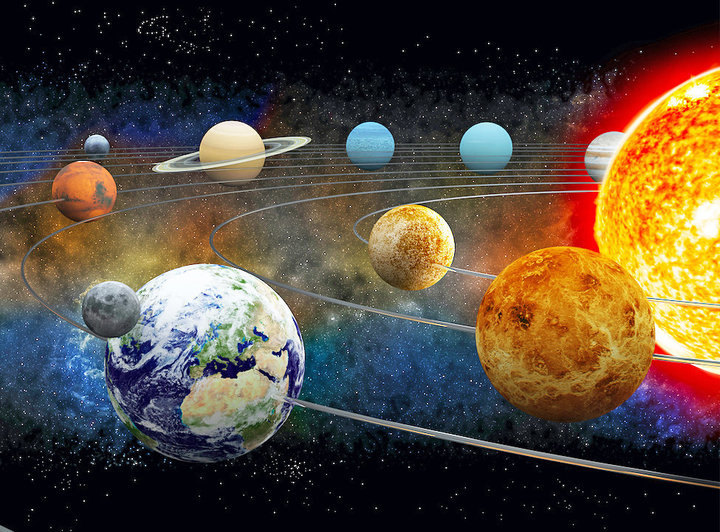As far as we know, Earth is the only place in our solar system where humans can survive without a spacesuit.
据我们所知,地球是太阳系中唯一一个人类不用穿宇航服也能生存的地方。
So if we ventured outside the cushy confines of our home, how long would we live on the other planets?
那么,如果我们冒险走出地球这个舒适的家园,在其他星球上我们能存活多久呢?
Mercury, the closest planet to the Sun, is actually not the hottest of the bunch,
水星,离太阳最近的行星,虽然不是太阳系行星中最热的星球,
but it does have the most extreme variation of temperatures.
但它上面的温度变化确实是最极端的。
Scientists once believed Mercury was tidally locked -
过去,科学家们以为水星也是潮汐锁定的——
meaning only one side of the planet faced the Sun, which explains why one side is so hot while the other is so cold.
也即只有一面是面对太阳的,这就解释了水星上为什么会一边巨热另一边巨冷。
But Mercury does rotate, just incredibly slow.
但水星其实是会自转的,只是转得太慢了。
At its current rotational velocity,
在当前的转速下,
it takes about 176 Earth days to experience one Mercurian day-night cycle.
在水星上经历一次昼夜循环就需要176个地球日。
But you wouldn’t make it to the next day because you would die in about two minutes due to freezing or burning up.
但事实上你根本活不到第二天,因为两分钟之内,你就会死于冻伤或灼伤。
Mercury’s neighbor, Venus, is often thought of as Earth’s twin sister because of the planets’ similar size and composition.
水星的邻居金星通常被认为是地球的孪生姐妹,因为这两颗行星的大小和组成都颇为相似。
But, the grass isn’t greener on the other side because well there is no grass at all.
不过,那山并不比这山高,因为那边根本就没有山。
The planet’s atmosphere, composed mainly of thick carbon dioxide, traps the Sun’s heat
金星的大气层,主要是浓浓的二氧化碳,会锁住太阳的热量,
causing scorching surface temperatures higher than 470 degrees Celsius.
导致金星表面的温度超470℃。
The excess amount of CO2 molecules scatter the Sun’s light, staining the sky a reddish orange.
过量的二氧化碳分子会分散太阳光,把天空染成红橙色。
You better take in that unusual view real fast
你最好赶快看一眼这一奇观异景,
because it’s the last thing you’ll see since Venus will vaporize you in less than one second.
因为不到一秒的时间内你就会被蒸发,所以那将是你生前看到的最后一个画面。
Mars is the hottest contender for humanity’s future home, and living there will literally take your breath away.
火星是人类未来家园中最热门的竞争者,弹住在那里会让呼吸都变得困难。
Despite its flaming red color, Mars is not hot.
尽管火星呈火红色,它上面并不热:
The average annual temperature is minus 60 degrees celsius with a low of minus 153 degrees.
火星年平均气温为-60℃,最低气温为-153℃。
The Red Planet’s barely there air will have you begging for a breath, and silicate dust will begin to cloud your lungs.
这颗红色星球上几乎没有空气,在上面呼吸都会变成一种奢求,就算能呼吸,硅酸盐粉尘也会开始笼罩你的肺部。
Within about two minutes Mars’s low atmospheric pressure will cause your organs to rupture resulting in a quick but painful death.
大约两分钟内,火星的低气压就会导致你器官破裂,继而迅速而痛苦地死去。
Jupiter is nice to look at but if you touch it, you'll die.
木星看起来很漂亮,但是只要你一碰它,你就药丸。
As far as we know, the gas giant has no surface,
据我们所知,这个气态巨星没有表面,
so your body will descend through cloud-like layers of mostly hydrogen and helium.
所以你的身体会在一层一层的,主要成分为氢和氦的云状气体里逐渐下降。

As you fall deeper, temperature and pressure will rise.
随着你下落得越深,温度和压力会上升。
But you won’t feel anything because the pressure killed you less than one second after arriving on the planet.
但你不会有任何感觉,因为压力会在你到达这个星球不到一秒的时间内把你杀死。
Saturn is another work of universal art.
土星是宇宙里的另一件艺术品。
Driving across those rings would be like Rainbow Road in real life.
开着飞船穿越这些土星环就像开车行驶在现实生活中的彩虹路上一样。
Except not at all because Saturn’s rings aren’t solid.
除了,事实上的感觉完全不是这样,因为土星环不是固体,
They’re made up of billions of particles that range in size and are almost entirely water ice.
而是由数十亿个大小不等的粒子——这些粒子几乎都是水冰——组成的。
And you likely won’t find solid ground on the planet itself.
而且,你很可能在这座星球上找不到坚实的地面。
Like Jupiter, the gassy composition of Saturn would swallow your lifeless body faster than the tick of a clock.
和木星一样,土星的气体成分也会在不到一秒的时间内吞噬掉你已经毫无生气的身体。
Uranus and Neptune don’t offer any hope of survival either.
天王星和海王星上也没有任何生存的希望。
And you’d likely die of boredom on the way there, considering the billions of kilometers of travel anyway.
而且,你可能在去这两颗星球的路上就已经无聊死了,毕竟它们距离地球有上亿公里的路程。
The ice giants are made up of mostly swirling fluids,
这两颗冰冻的巨星主要由旋涡状的液体组成,
but they get their blue hues from methane gas in their atmospheres, which would cause you to suffocate.
但它们的蓝色来自于其大气中的甲烷,而甲烷的这种气体是会让你窒息的。
On top of the toxic gas, the extreme temperatures on both planets would contribute to a nearly instant death.
除了甲烷这种有毒气体,这两颗行星上的极端温度也会导致你几乎瞬间死亡。
We are pretty lucky to live on Earth.
能生活在地球上我们是很幸运的。
Our planet’s proximity to the Sun enables water to exist in liquid form, regulates temperatures and provides energy for photosynthesis.
我们的星球离太阳很近,这使得水能以液体的形式存在,从而调节地球上的温度并为光合作用提供能量。
Earth’s atmosphere has a perfect mix of gases that allow us to breath
地球的大气层有着完美的混合气体,让我们可以自由地呼吸,
and the planet’s relatively stable magnetic field keeps solar storms from frying us to a crisp.
而地球相对稳定的磁场也使太阳风暴不会把我们炸成脆饼。
So, be thankful for our planet and treat her well,
所以,请对我们的星球心存感恩,善待她,
because no one wants to spend their entire life in a spacesuit.
因为没有人愿意一辈子都呆在太空服里。
Space Crafts takes you through the depths of the cosmos,
“宇宙飞船”系列视频将带你穿越宇宙的深处,
explaining bizarre astronomical phenomena and crazy plans for future exploration.
解释奇异的天文现象和未来探索的疯狂计划。
Check out other episodes like this one about the quest for finding the mysterious Planet Nine.
其他期的视频也请不要错过,比如这期视频就讲述了寻找神秘的“九号行星”的故事。
Thanks for watching Seeker!
感谢收看《科学探索之旅》!
Don’t forget to subscribe.
别忘了订阅噢。


